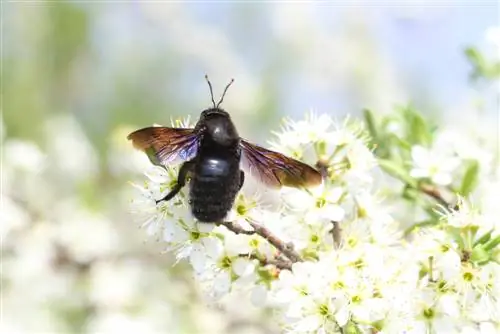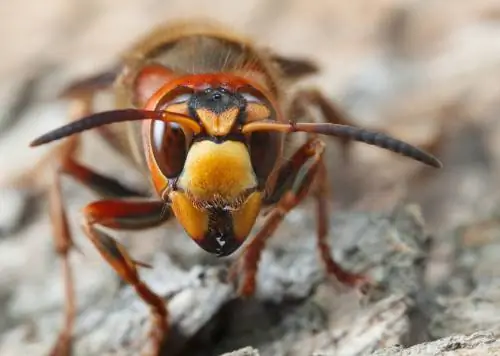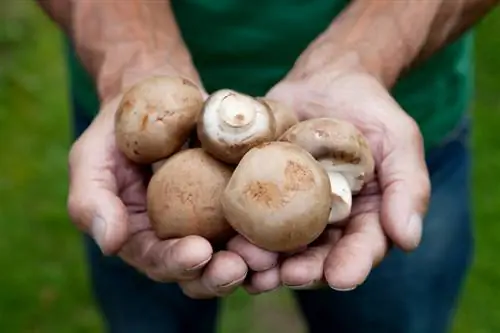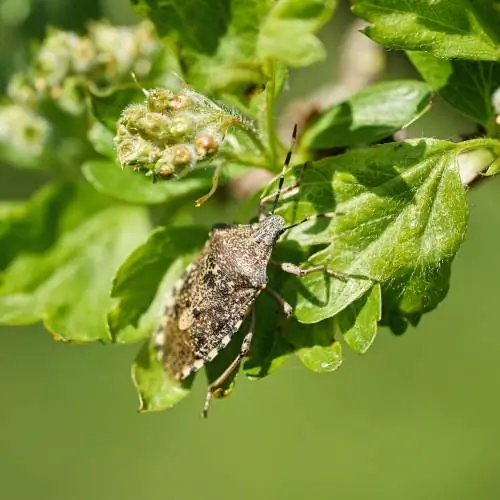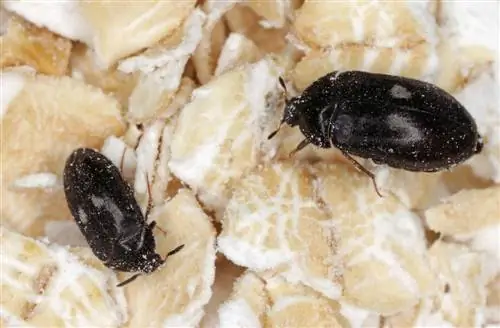- Author admin [email protected].
- Public 2023-12-24 06:09.
- Last modified 2025-01-23 11:22.
Many hobby gardeners are shocked when they discover a black colored bumblebee-like insect in their garden. They suspect that it is a dangerous hornet. There is no need to panic as this species proves to be an interesting garden visitor that needs protection.
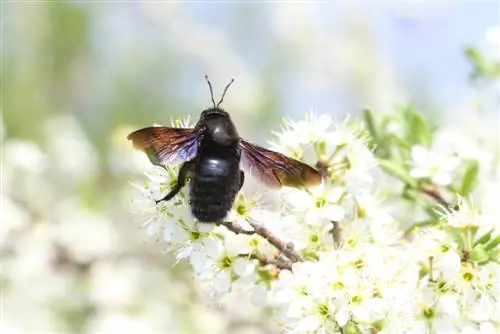
Is the black hornet dangerous?
The so-called “black hornet” is not a hornet, but a harmless species of bee called the blue-black carpenter bee (Xylocopa violacea). It is the largest native bee species in Europe and has a blue-black body and blue wings. Carpenter bees are beneficial pollinators and are not a threat to humans.
Who is the black hornet?
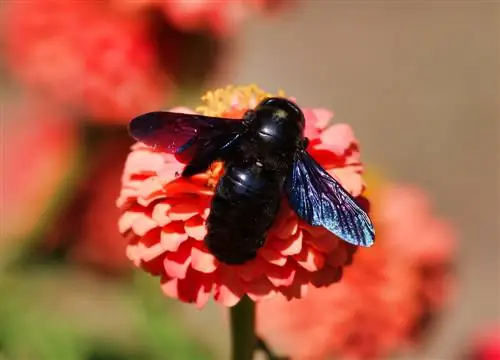
The black bee is impressively large
Once you have seen this insect, you will never forget it. With a bumblebee-like body and a striking size of between 20 and 28 millimeters, the animal appears almost frightening. In fact, it is the largest native bee species that does not belong to either bumblebees or hornets. It is the blue-black carpenter bee with the scientific name Xylocopa violacea.
Typical and striking features:
- blue wings
- blueblack body
- black hair
Dissemination
The insect has many names such as blue, violet or large carpenter bee. The species is native to southern and central Europe. Until the 1980s, the distribution area in Germany extended to the Upper Rhine plain. Since 2003, the carpenter bee has increasingly spread northwards. Today it can be observed as far away as Schleswig-Holstein and partly in southern Sweden.
Frequency in Germany
While the carpenter bee was classified as critically endangered in the 1980s, the population has since recovered. By abandoning orchards, nature was able to develop independently, resulting in more deadwood stands. At the same time, the heat-loving species is favored by rising temperatures, allowing it to spread north. But suitable nesting places are also in short supply in warmer areas of Germany, so carpenter bees rarely appear there.
The carpenter bee lives here:
- on orchards with dead trees
- on structurally rich forest edges
- in natural gardens and parks
Are there more than one species?
In the warmer regions within German-speaking countries you can observe three types of carpenter bees between April and August. They are difficult to distinguish based on their physical characteristics. At 15 to 18 millimeters long, the small carpenter bee is smaller than its relatives. The blue-black carpenter bee usually grows between 20 and 25 millimeters in size, while the eastern carpenter bee reaches a body length of 22 to 28 millimeters.
| German | Dissemination | Nisting site | |
|---|---|---|---|
| Xylocopa violacea | Big carpenter bee | Austria, Switzerland, Germany | rotten dead wood and thicker stems |
| Xylocopa valga | Eastern carpenter bee | Austria, Switzerland, Germany | rotten deadwood |
| Xylocopa iris | Little carpenter bee | Austria, Switzerland; lost in Germany | pith-containing stems, diameter: 11-16 mm |
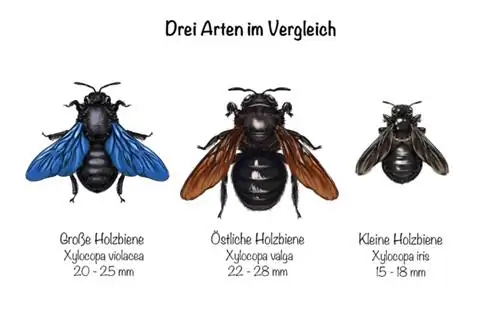
Lifestyle and development
Carpenter bees in Central Europe live solitary lives. They dig their own tunnels into crumbly dead wood or plant stems containing pith using the insects' powerful upper jaws. Depending on the thickness of the tissue, carpenter bees gnaw a tunnel or a complete system of several parallel tunnels that branch off from a main tunnel. While the nest entrance remains open, carpenter bees close the brood cells in their nesting passages with a substance made from wood or plant pulp particles and saliva. They are lined with a waterproof substance so that the brood is optimally protected.

Development
When the warm rays of sunshine herald spring, carpenter bees wake up from hibernation and start looking for a partner. It takes no longer than two months for the egg to develop into an adult carpenter bee. The insects produce one generation per year. Females live an unusually long time for bees, so they get to know their offspring themselves. This ability to survive is otherwise known from furrow and clubhorn bees.
The impressive brummers like sunny habitats with a large variety of flowers and lots of dead wood.
How carpenter bees overwinter
Before carpenter bees go into hibernation, they spend the rest of the year exploring their surroundings. To hibernate, they retreat to their natal nests or look for other hiding places. Their hibernation strategy differs from the concept pursued by hornets:
| Carpenter Bee | hornet | |
|---|---|---|
| Who hibernates? | both genders | mated young queens |
| What is needed? | mostly above-ground, protected crevices | light-poor, rain-protected cavities |
| Where do people overwinter? | Cracks in walls, holes in the ground, own nests | Tree hollows, attics, bird nesting boxes, dead wood |
| How do you overwinter? | individually or in small groups | individually, rarely in small groups |
What do carpenter bees feed on?
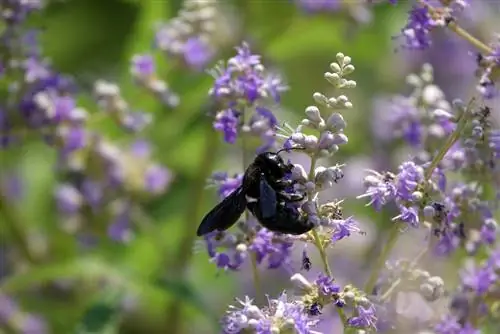
Carpenter bees also collect pollen and nectar
Carpenter bees feed on pollen and nectar from various plants. Early flowering species are of great importance because the insects are already busy building nests from April onwards. In the crop and with the help of the hind legs they transport the pollen to their nests to feed the brood. Their food spectrum is wide-ranging and should continue until mid-summer:
Carpenter bees prefer large-flowered plants:
- Lamiaceae: Winter jasmine, sage, Ziest
- Asteraceae: Meadow knapweed, thistles
- Rough leaf family: Adderhead
- Butterflies: Chinese and Japanese wisteria, sweet peas
Tip
Carpenter bees are considered to be loyal to their location and always return to their old breeding places. Therefore, you should not make any intensive changes to your garden.
Excursus
Intelligent beings?
If the flowers are large enough, the carpenter bees use the normal entry gate via the flower opening. They touch the flower organs and act as pollinators. Most of the pollen is transported with their crop. Occasionally the insects use another method of obtaining food.
As so-called nectar robbers, carpenter bees use their powerful mouthparts to gnaw through the flower tube. In this way they get the coveted nectar of deep flowers, which their long tongues cannot reach through normal routes. In this form, the insects get food without doing anything in return for pollination.
Poisonous and dangerous?
The carpenter bee has a stinger with which it can inject its venom into a potential attacker. This happens extremely rarely as the species does not behave aggressively. You only need to worry about a sting if you crush or otherwise threaten the insect.
Tip
If you collect wild herbs for your own use, you should leave the bouquets in the fresh air for a while before washing and then shake them out well. This way, hidden guests can get away and you can avoid getting stung.
Frequently asked questions
How can I help the black hornet?
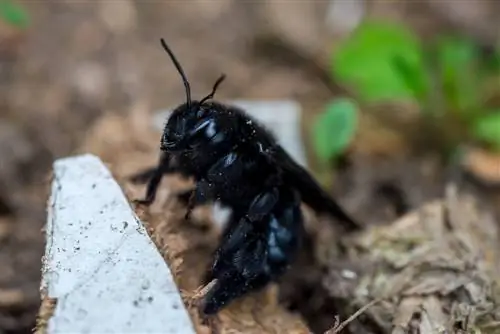
Rotten wood provides shelter for the black hornet
Carpenter bees rely on dead wood, which is becoming rarer in tidy gardens or forests as well as in fields. Well-intentioned clean-up work destroys the carpenter bee's valuable habitat. Leave trunks of dead trees standing or create a pile of thick trunks to provide a retreat for the impressive species. With a variety of species of basket plants, butterflies and labiate plants, you offer the insect important food.
Design tips:
- place rotten stumps on a stone slab if the ground is wet
- lay out dead tree trunks on dry sandy soil
- tie dead branches diagonally to trees
- Combine early bloomers and summer bloomers
A strange black hornet that is about two centimeters long has settled in our half-timbered house. Like a woodworm, it drills thick holes in the beams so that sawdust falls out. What can we do about it?
Carpenter bees don't stop at half-timbered houses if the wood has become brittle as a result of the natural aging process. If your structure has been populated, this is an indicator of aging. It represents an ideal nesting place. To prevent such an “infestation”, you should protect the wood from weathering. Treat it with glazes (€23.00 on Amazon) and varnishes to deter carpenter bees. Avoid injuries to the wood caused by saw cuts or nail holes. Such cavities are often populated.
Stop settlement that has already begun:
- Place fruit tree stumps or old pieces of beams nearby
- Drill holes as an incentive for new settlement
- Cover entry holes in the beams
What are these black giant hornets that appear in Turkey or Croatia?
There are various species of the hornet genus that can reach impressive dimensions. The Asian hornet (Vespula mandarinia) attracted particular attention. The species reaches dimensions of between 27 and 55 millimeters and is characterized by a predominantly black abdomen with a wide yellow band. However, alleged sightings of this giant hornet in Europe are confusion with other species, as this insect is found in East and Southeast Asia:
- Oriental hornet (Vespula orientalis) lives in southeastern Europe, e.g. Turkey
- Vespa velutina (colloquially: Asian hornet) was introduced to Europe
How do carpenter bees collect their nectar?
Females collect pollen mainly in their crop but also with their hind legs. It crawls into the nest into the brood cell and turns to face the entrance. By grooming the hind legs the pollen is removed. The female solidifies the particles on the ground using her head and mouthparts. Sometimes it rotates several times before all the pollen is cleaned off and piled up.
How do carpenter bees process the collected nectar?
The females mix the pollen particle by particle with honey until it forms a paste. This is deposited in a separate passage that is parallel to the nest entrance. The color of the paste differs depending on the nectar collected. It varies between brown, dark red, dark green and beige.

